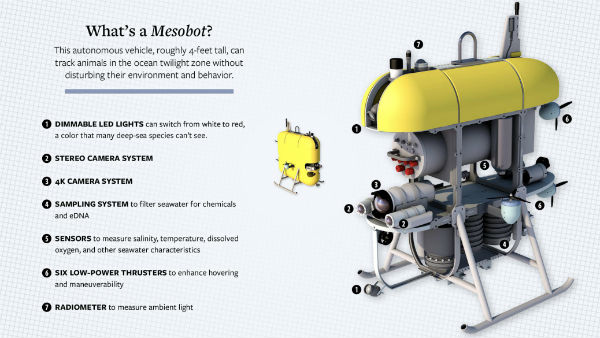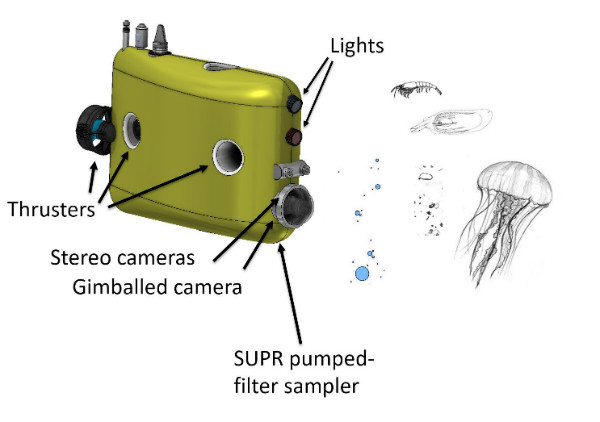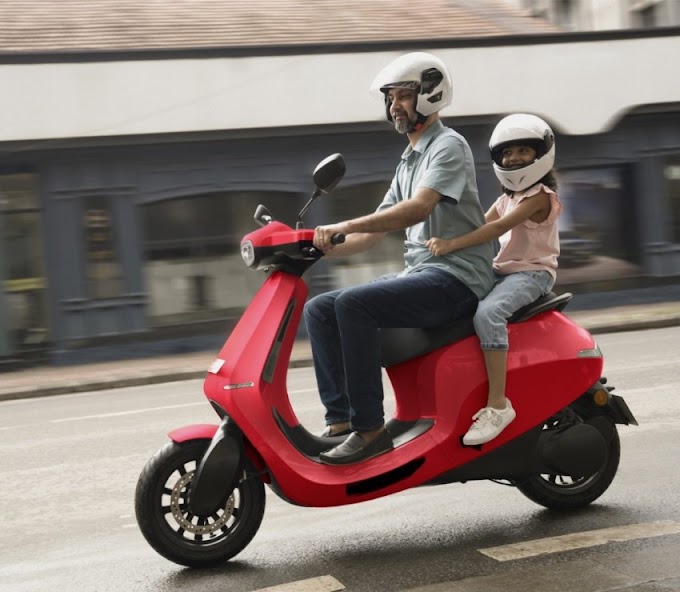Mesobot, is an underwater deep sea robot developed at Woods Hole Oceanographic Institute (WHOI) in the United States. It is equipped with a series of sensors and probably artificial intelligence so that it can autonomously follow small particles under water like a jellyfish, and capture high-resolution images of the ocean life. Mesobot is ready for tank tests and will take its first plunge into the twilight zone by the summer 2019.
 |
| Mesobot |
This robot, Mesobot, will be able to follow the organisms
for up to 48 hours. The robot becomes a new tool for understanding this
process. For the Mesobot to work it would need to have the characteristics of a diver too.
A scuba diver does his best to merge with the environment
without making any noise and less movements but he can't stop the bubbles out
of the scuba tanks. This is where Mesobot will work(play safe), i.e. to be
camouflaged with the environment.
So this new Robot, Mesobot is designed to dive deeper very quietly so
that the ocean beings don't get disturbed and get conscious and their behaviour
gets studied in the most natural manner possible.
Let’s look at the quick features of deep sea Mesobot(from WHOI’s website), what it is having and what it can do:
It's
4-foot-tall, and looks like a bright-yellow bar of soap
Weighs
about 350 pounds
Battery
power will last up to two days
Will
explore the ocean in too deep, into the twilight zone, hundreds to thousands of
feet below the surface
Will
be able to follow individual organisms, fishes and other ocean beings, studying
and capturing their secrets and behaviour
six
large, low-powered thrusters are used:
2 side thrusters, 2 vertical, and 2
aft.
Switchable
LED lights from white to red(twilight
zone species cannot see these colors)
Will
carry - instruments that measure salinity, temperature, dissolved oxygen, and
other seawater characteristics, and a Suspended Particulate Rosette (SUPR)
sampler. (It was developed for analyzing
water chemistry, and it's filters could also be used to collect samples of
environmental DNA)
“You can extract the DNA from a plankton
sample to identify the species composition,”
“Or you can filter environmental DNA—or eDNA—from a water sample,
compare it to the DNA of known species, and identify what organisms were in the
water.” -- says Govindarajan, team researcher.
Cameras
- 2 camera systems:
a
pair of stereo cameras for locating target animals and a camera to record what they do, in 4K
video or 12 megapixel stills.
 |
| Mesobot Features |
What are Mesopelagic organisms?
These are the small fish, krill and jellyfish that are on
the open sea. The mesopelagic fish alone, according to the Norwegian Marine
Research Institute, make up 100 times more biomass than all the fish caught
every year in the world.
The faeces from the mesopelagic organisms sink, as opposed
to, for example, the faeces of a whale flowing. That is what makes the CO2 fall
to the bottom.
To study the CO2 deposition in the ocean.
Plankton and small animals in the deep sea contribute to a
natural CO2 storage through one of the largest animal migrations taking place
on Earth. The organisms are high in the sea when it is dark and move deeper
down as the sun shines. And down the road they take CO2 with them.
How much CO2 comes down, and whether it even remains down
there, we don't know yet. But with the underwater Robot, Mesobot, scientists
now have to try to investigate this more closely - and thus find out how
important these marine organisms are to the greenhouse gas balance in the
atmosphere.
The process where CO2 is taken out of circulation by the
organisms that sink during the day is also called the Biological CO2 pump.
It is the phytoplankton that takes CO2, but animals like krill eat the
phytoplankton. And krill then becomes food for other species up in the food
chain. Some of the CO2 from these organisms drops with waste materials, and
since there are so many of them, it becomes very much CO2.
Sea can be fertilized
It is possible to give the natural process an extra kick by
fertilizing the sea with dissolved iron. The iron content of the sea is in many
cases what limits the blooming of phytoplankton in the deep sea. If you add iron,
you also increase the amount of phytoplankton and thus indirectly the amount of
mesopelagic organisms.
More fishing
Interest in utilizing the mesopelagic species has increased
in recent years. The commercial fishing for krill which is used in health food,
and experimental fishing for water fleas has been opened. Experiments have also
been carried out on fishing for mesopelagic fish as prick fish, mainly for use
as an ingredient in food.
Mesobot, can contribute to better management of the
mesopelagic species.






